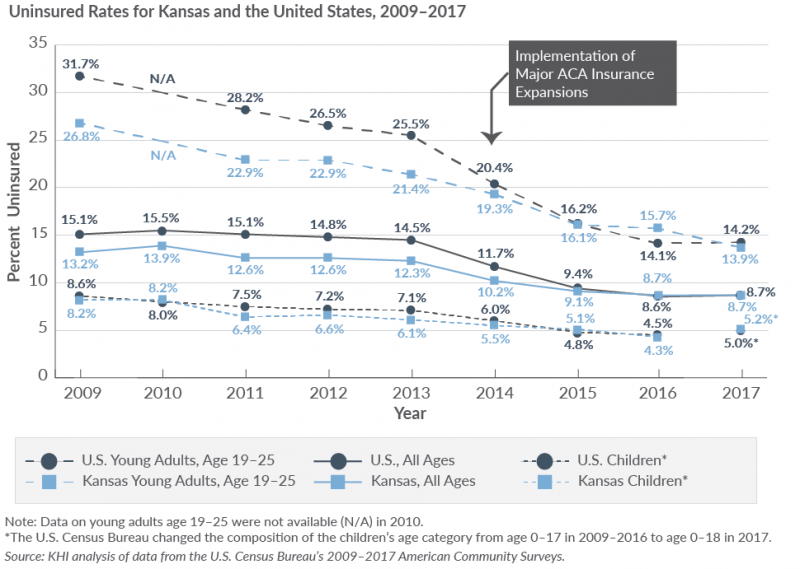TOPEKA — The U.S. Census Bureau today released its latest estimates on health insurance coverage. After consistent drops each year following implementation of the Affordable Care Act (ACA), the uninsured rate in the U.S. showed no significant change from 2016 to 2017. Following similar drops, the uninsured rate in Kansas remained unchanged for the second consecutive year.
The U.S. uninsured rate was 8.7 percent in 2017, not significantly different from 8.6 percent in 2016. The Kansas uninsured rate was 8.7 percent in both 2017 and 2016. This represents 28.0 million uninsured Americans and 249,000 uninsured Kansans in 2017.
In other findings for 2017:
-
- Kansas children age 0−18 were as likely to be uninsured as children nationally (5.2 percent in Kansas compared to 5.0 percent for the U.S.).
- Young adults in Kansas age 19−25 were as likely to be uninsured as other people their age around the country (13.9 percent in Kansas compared to 14.2 percent for the U.S.). Starting in 2010, the ACA allowed young adults to be covered under their parent’s insurance until age 26.
- Minorities were more likely to be uninsured than Whites both in Kansas and around the country (In Kansas, 20.4 percent for Hispanic(s), Any Race and 12.6 percent for Black/African Americans compared to 6.5 percent for Non-Hispanic Whites; and in the U.S., 17.8 percent for Hispanic(s), Any Race and 10.0 percent for Black/African Americans compared to 5.9 percent for Non-Hispanic Whites).
- Minorities in Kansas were more likely to be uninsured than those in other states (see uninsured rates for minorities in previous bullet).
- Non-Hispanic White Kansans were more likely to be uninsured than those in other states (6.5 percent in Kansas compared to 5.9 percent for the U.S.).
- Kansans living below the poverty line were more likely to be uninsured than poor persons living in other states (20.6 percent in Kansas compared to 15.9 percent for the U.S.).
“The impressive gains in insurance coverage since the implementation of the ACA have certainly flattened out in the U.S. and in Kansas,” said Robert F. St. Peter, M.D., President and CEO of the Kansas Health Institute. “How much of that is due to confusion or hesitancy related to the continued political battles around the ACA, and how much is due to other factors is hard to say. In states that have already expanded Medicaid, additional gains in insurance coverage are going to be increasingly difficult to achieve. Those persons remaining uninsured are difficult to reach for a number of reasons. For states that have not expanded Medicaid, like Kansas, one thing that clearly has been shown to significantly drop the uninsured rate is Medicaid expansion.”
The U.S. Census Bureau will release additional data with state-level detail on October 18, 2018. KHI will perform additional analysis of these data when available. Please check our website frequently for additional information.
NOTE: This analysis uses data from the 2009−2017 American Community Survey (ACS) 1-year Estimates released today. Earlier this week, the U.S. Census Bureau also released data from the 2017 Current Population Survey (CPS). Estimates of insurance coverage may differ slightly between the ACS and CPS. The ACS estimates are better for analyzing state-level data and therefore were used in this analysis.
